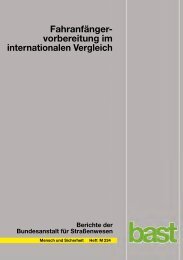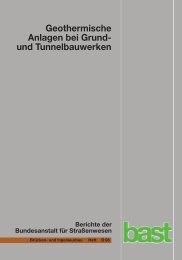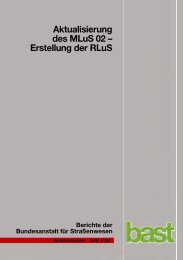Dokument 1.pdf - ELBA: Das elektronische BASt-Archiv - hbz
Dokument 1.pdf - ELBA: Das elektronische BASt-Archiv - hbz
Dokument 1.pdf - ELBA: Das elektronische BASt-Archiv - hbz
Erfolgreiche ePaper selbst erstellen
Machen Sie aus Ihren PDF Publikationen ein blätterbares Flipbook mit unserer einzigartigen Google optimierten e-Paper Software.
4<br />
Assessment of driver fatigue<br />
Driver fatigue is a contributing factor in an<br />
estimated 10-20% of road accidents. A huge<br />
number of different methods is available to assess<br />
driver fatigue. The project’s goal was to describe<br />
and compare the strengths and weaknesses of<br />
different methods to assess driver fatigue and to<br />
present an overview of the existing fatigue<br />
detection and fatigue warning systems. The<br />
evaluation of these methods and systems is based<br />
on literature analysis and interviews with experts<br />
and users. The following procedures were taken:<br />
• Literature analysis and overview of physiological<br />
and performance-based methods to assess<br />
driver fatigue.<br />
• Literature analysis of fatigue detection and<br />
warning systems, interviews with their<br />
manufacturers and overview of the identified<br />
systems.<br />
• Interviews with 20 users of currently in middleand<br />
upper-class cars implemented fatigue<br />
warning systems to assess the perceived quality<br />
of fatigue detection, driver acceptance and<br />
compliance.<br />
• Development of a list of criteria to assess and<br />
compare the quality of the most valid methods to<br />
assess driver fatigue.<br />
• Two-stage survey (Delphi-Study) with 12<br />
experts from academic and industrial research<br />
areas. It was aimed at the selection and<br />
evaluation of the most valid methods to assess<br />
driver fatigue, their subsequent re-evaluation<br />
providing explanatory statements in case of<br />
contradicting opinions, and the assessment of<br />
the methods’ suitability for different fields of<br />
application.<br />
users’ point of view. Several drivers continue to<br />
drive even despite of a system’s warning that they<br />
perceive as accurate. About half of them perceive<br />
fatigue warning systems as a gain in safety.<br />
The most valid methods to assess driver fatigue<br />
selected by the 12 experts are the assessment of<br />
driving performance (steering behaviour and lane<br />
keeping) and eyelid closure, video-based expert<br />
assessments, EEG and (quite controversial) the<br />
Pupillographic Sleepiness Test. Their differing<br />
strengths and weaknesses are extensively<br />
described in the report at hand.<br />
There is still no gold standard of fatigue<br />
assessment. Depending on the fields of application<br />
all six of the selected methods (research &<br />
development), only a few (fatigue warning systems)<br />
or none of them (traffic controls) are applicable.<br />
When choosing a method the goal and context of<br />
fatigue assessment and the strengths and<br />
weaknesses of the respective methods should be<br />
considered. The combination of at least two<br />
different methods is recommended to achieve a<br />
valid assessment of driver fatigue.<br />
Fatigue detection systems and the most promising<br />
methods to assess driver fatigue should be further<br />
optimized and accompanying studies need to be<br />
conducted. Further measures to effectively reduce<br />
the number of accidents were discussed during the<br />
workshop and presented in the report at hand.<br />
• Workshop with the experts that participated in<br />
the Delphi-Study to discuss and complement the<br />
obtained results.<br />
70 fatigue detection systems were identified. They<br />
differ in their underlying methods to assess fatigue,<br />
their availability and design of driver feedback, and<br />
in their prevalence. Convincing evidence of their<br />
validity or the percentage of false and missed<br />
alarms are rarely reported. The fatigue warning<br />
systems that are more and more implemented in<br />
middle- and upper-class cars often fail to provide a<br />
satisfying fatigue detection performance from a
















